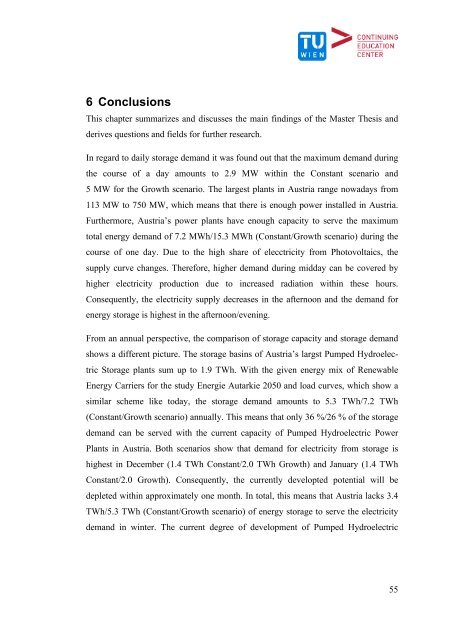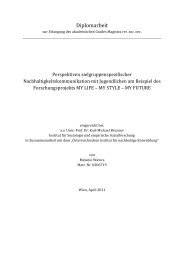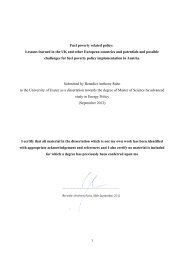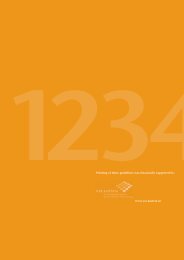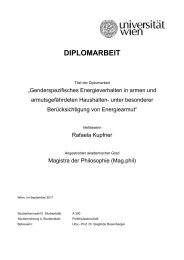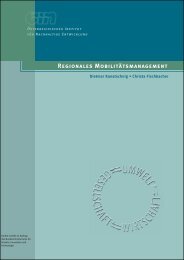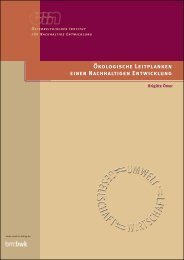The relevance of energy storages for an autarky of electricity supply ...
The relevance of energy storages for an autarky of electricity supply ...
The relevance of energy storages for an autarky of electricity supply ...
Create successful ePaper yourself
Turn your PDF publications into a flip-book with our unique Google optimized e-Paper software.
6 Conclusions<br />
This chapter summarizes <strong>an</strong>d discusses the main findings <strong>of</strong> the Master <strong>The</strong>sis <strong>an</strong>d<br />
derives questions <strong>an</strong>d fields <strong>for</strong> further research.<br />
In regard to daily storage dem<strong>an</strong>d it was found out that the maximum dem<strong>an</strong>d during<br />
the course <strong>of</strong> a day amounts to 2.9 MW within the Const<strong>an</strong>t scenario <strong>an</strong>d<br />
5 MW <strong>for</strong> the Growth scenario. <strong>The</strong> largest pl<strong>an</strong>ts in Austria r<strong>an</strong>ge nowadays from<br />
113 MW to 750 MW, which me<strong>an</strong>s that there is enough power installed in Austria.<br />
Furthermore, Austria’s power pl<strong>an</strong>ts have enough capacity to serve the maximum<br />
total <strong>energy</strong> dem<strong>an</strong>d <strong>of</strong> 7.2 MWh/15.3 MWh (Const<strong>an</strong>t/Growth scenario) during the<br />
course <strong>of</strong> one day. Due to the high share <strong>of</strong> elecctricity from Photovoltaics, the<br />
<strong>supply</strong> curve ch<strong>an</strong>ges. <strong>The</strong>re<strong>for</strong>e, higher dem<strong>an</strong>d during midday c<strong>an</strong> be covered by<br />
higher <strong>electricity</strong> production due to increased radiation within these hours.<br />
Consequently, the <strong>electricity</strong> <strong>supply</strong> decreases in the afternoon <strong>an</strong>d the dem<strong>an</strong>d <strong>for</strong><br />
<strong>energy</strong> storage is highest in the afternoon/evening.<br />
From <strong>an</strong> <strong>an</strong>nual perspective, the comparison <strong>of</strong> storage capacity <strong>an</strong>d storage dem<strong>an</strong>d<br />
shows a different picture. <strong>The</strong> storage basins <strong>of</strong> Austria’s largst Pumped Hydroelec-<br />
tric Storage pl<strong>an</strong>ts sum up to 1.9 TWh. With the given <strong>energy</strong> mix <strong>of</strong> Renewable<br />
Energy Carriers <strong>for</strong> the study Energie Autarkie 2050 <strong>an</strong>d load curves, which show a<br />
similar scheme like today, the storage dem<strong>an</strong>d amounts to 5.3 TWh/7.2 TWh<br />
(Const<strong>an</strong>t/Growth scenario) <strong>an</strong>nually. This me<strong>an</strong>s that only 36 %/26 % <strong>of</strong> the storage<br />
dem<strong>an</strong>d c<strong>an</strong> be served with the current capacity <strong>of</strong> Pumped Hydroelectric Power<br />
Pl<strong>an</strong>ts in Austria. Both scenarios show that dem<strong>an</strong>d <strong>for</strong> <strong>electricity</strong> from storage is<br />
highest in December (1.4 TWh Const<strong>an</strong>t/2.0 TWh Growth) <strong>an</strong>d J<strong>an</strong>uary (1.4 TWh<br />
Const<strong>an</strong>t/2.0 Growth). Consequently, the currently developted potential will be<br />
depleted within approximately one month. In total, this me<strong>an</strong>s that Austria lacks 3.4<br />
TWh/5.3 TWh (Const<strong>an</strong>t/Growth scenario) <strong>of</strong> <strong>energy</strong> storage to serve the <strong>electricity</strong><br />
dem<strong>an</strong>d in winter. <strong>The</strong> current degree <strong>of</strong> development <strong>of</strong> Pumped Hydroelectric<br />
55


